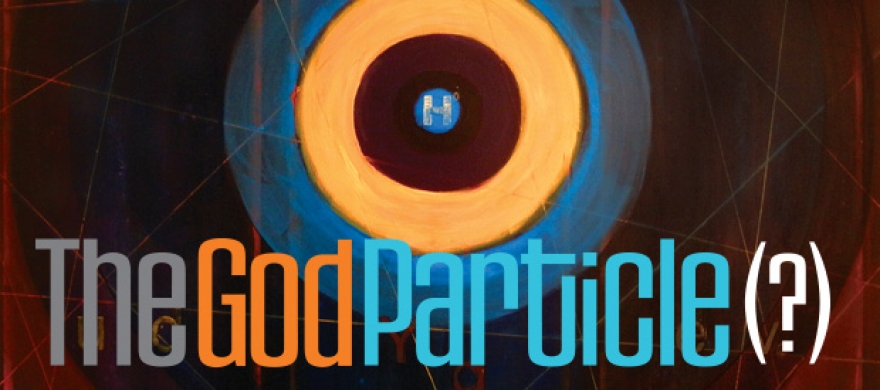The God Particle (?)
Pepperdine professors take on the science, faith, and mystery of the Higgs Boson.
WHY DOES ANYTHING EXIST?
It’s a big question—one that has sparked the spirit, intellect, and imagination of human beings since time began. It challenges the core of who we are, how we got here, and what we are called to do.
On July 4, 2012, teams working at the Large Hadron Collider at CERN in Switzerland announced a discovery that brought this question to life in headlines and conversation around the world.
Scientists detected the first evidence of the Higgs Boson, a particle that explains the origin of mass of all things and was famously dubbed the “God Particle” in 1993. The breakthrough ended a decades-long search towards completing an understanding of sub-atomic particles known in physics as the Standard Model.
Could this discovery explain key concepts of our existence? What does it mean to our
understanding of matter and the universe?
As the subject continues to make news and fuel dialogue, Pepperdine Magazine asks Seaver College professors of physics, religion, and philosophy for their take
on the Higgs boson, its controversial nickname, and what it all means from a Christian
perspective.
GERARD FASEL: visiting professor of physics and coordinator of 3/2 engineering 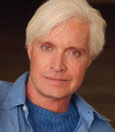
Higgs Boson
Named after physicist Peter Higgs, University of Edinburgh. He developed the idea,
along with other physicists, of the Higgs mechanism, and from that, the particle (boson),
which explains the origin of mass of elementary particles, and by extension, all things.
The Higgs Boson, named after Peter Higgs, the man who is generally credited with predicting its existence (credit is also due to physicists Robert Brout and Francois Englert), was called the “God Particle” by Leon Lederman in a book bearing the same title in 1993. The Higgs Boson is associated with the Higgs field, which is thought to be the mechanism that gives mass to particles that inhabit our universe, including the ones that make up the structure of humans. Its recent discovery completes the table of particles of the Standard Model of physics.
The way that this mechanism works is that particles interact with the Higgs field via the Higgs Boson. The greater the interaction of the particle with the Higgs field the greater the mass of the particle. you can visualize this mechanism by considering two large swimming pools, one filled with water and the other tar. You would find walking or exercising in the pool filled with water easier than the pool filled with tar. The less resistance you encounter the easier it is to move. Trying to move in the pool with tar would require an extreme amount of effort; consider the animals trapped in the La Brea tar pits in Los Angeles. The same holds for a particle moving through the Higgs field; the greater the resistance it encounters moving through the field the greater the mass of the particle. Particles like photons do not interact with the Higgs field and therefore do not have mass.
Even though the Higgs mechanism appears to know how much interference to exert on the different types of particles, this does not imply that the Higgs particle is omniscient. The Higgs particle comes up a little short in the all-knowing category. To be “the God Particle” it must play a bigger role in the evolution of our universe. Maybe it would be a good spokesparticle for Weight Watchers but not “the God Particle.”
JAY BREWSTER: associate provost and professor of biology 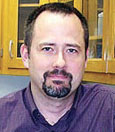
God Particle
Name given to the Higgs boson by Nobel Prizewinner in Physics and former Fermilab
director, Leon Lederman, in his 1993 book The God Particle: If the Universe Is the
Answer, What Is the Question?
The July 4 announcement at CERN revealing experimental evidence of the Higgs boson particle was a breathtaking historical moment in the sciences. This 48-year quest began with mathematical predictions regarding components of the Standard Model of particle physics. The importance of the discovery is clear, advancing our understanding of the subatomic particles that compose the known universe, and the forces that hold these particles together (and push them apart). However, celebration of the discovery has been muddled by a popular reference to the Higgs boson as the “God Particle.” Though this discovery clearly improves our understanding of the physical universe, there is nothing about the Standard Model that addresses questions regarding God’s existence. God will not be proven or dismissed by scientific revelation.
Discoveries in the fields of particle physics or cosmology unravel a universe with seemingly unlimited surprises, though big questions remain. What is the nature of time? What was the beginning of the universe like? I struggle to understand a universe that sprang into existence ex nihilo (from absolute void); something must have existed beforehand to provide the fuel for the universe-creating explosion. If so, where did that fuel originate? There are popular books available currently that offer a “something from nothing” explanation of the origin of the universe, an explanation that is typically offered along with some religion bashing. However, the nothing described in these books is actually something, which in my mind offers no real explanation at all. Time and origins are truly challenging characteristics of the universe that are mysterious, but not outside the realm of scientific investigation.
As a biologist and a Christian, I am accustomed to the insertion of new research discoveries into the faith and science conversation. The insertion seems out of place, as scientists experimentally test and describe the physical universe, and most resist any extension of their work into larger theological questions. However, there is a wonderful complex mystery to life itself, forcing us to consider its origin, and the likelihood of precursor molecules assembling into replicating cells.
For the believer, faith comes through a study of the word of God, through the spirit of God working within us, and through our daily experiences as we engage the majesty of the world around us. Scripture tells us that the heavens declare the glory of God each and every day (Psalms 19), and that God’s divine nature is made clear to us through what has been made (Romans 1:20). Paul, referencing the place of Christ in creation wrote, “He is before all things, and in him all things hold together” (Col. 1:17, NIV). For the believer in Christian scripture, God is eternal, outside of time, and is both the beginning and the end of all things. Ultimately we must ask ourselves which explanation makes the most sense: a purposed universe authored by God himself, or a meaningless universe that has sprung up by chance via a specific set of natural laws.
GARRETT PENDERGRAFT: assistant professor of philosophy 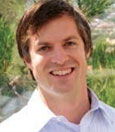
Large Hadron Collider (LHC)
Located at CERN near Geneva, Switzerland, the Large Hadron Collider is currently the
world’s largest and most powerful particle accelerator. A hadron is a subatomic particle
such as a proton or neutron.
When I first heard the term “God Particle,” it didn’t make much sense to me. Was it supposed to be some sort of evidence that God exists? (Probably not.) Was it supposed to explain the things God is typically invoked to explain? (That didn’t seem right either.) So I looked up where the term came from. Here’s what Lederman says (p. 22): “This boson is so central to the state of physics today, so crucial to our final understanding of the structure of matter, yet so elusive, that I have given it a nickname: the God Particle.”
So it seems that Lederman is drawing an analogy: he is saying that the Higgs boson is to physics as God is to (theistic) religion. And this analogy suggests a presupposition about the relation between science and religion—or, more precisely, a presupposition that science and religion are unrelated. They are, as Stephen Jay Gould would say, non-overlapping magisteria; neither one can say anything about the other. But I think this is an incorrect model of the relation between science and religion (or science and theology). I prefer a convergence model, according to which science and theology will eventually converge on a unified and truthful description of reality. (I owe this description of the convergence model to Garry DeWeese.)
Science and theology often tell us different kinds of things, but ultimately they’re talking about the same thing. When conflict occurs, it will be due to an incorrect theory in science or an incorrect doctrine in theology (or perhaps both). As we (haltingly) approach an accurate description of reality, science may correct theology or theology may correct science. Both disciplines are part of the broader search for God’s truth that we are committed to as Christians.
CHRIS DORAN: assistant professor of religion 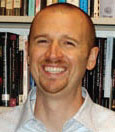
CERN
Established in 1954 as the Conseil Européen pour la Recherche Nucléaire (European
Council for Nuclear Research), or CERN for short, it is now known as the European
Organization for Nuclear Research.
After complaining that God was treating him unjustly, God comes to Job in a whirlwind, takes him on a tour of creation, and then demands answers from Job. “Where were you when I laid the foundation of the earth? Tell Me, if you have understanding” (Job 38:4 NAS). At the end of his encounter with God, Job pronounces one of the more enigmatic lines of scripture, “Therefore I retract, And I repent in dust and ashes” (Job 42:6 NAS). It is at this point that Job appears to comprehend the most profound of existential facts: God is God and he is not. God is the Creator and Job is a creature. It with this new understanding Job grasps something truly meaningful about himself and the nature of the universe.
With the recent discovery of the so-called “God Particle,” physicists now allow us to peer even deeper into the fundamental quantum structures that make up the reality that we see around us. As Christians, we might say that we now understand quite a bit more about “the foundation of the earth,” and how fascinating that foundation truly is. The discovery of the Higgs boson serves as a reminder that while the very substance of reality is indeed deeply mysterious, it is at the same time utterly intelligible. I hope that fact never ceases to amaze us, whether we be persons of faith or not, because there is no logical reason that the universe should be this orderly. In the face of this discovery, perhaps we should find ourselves in a similar position to that of Job and contemplate what our response might be. Will our response be one of awe, which causes us to consider anew what it means to live in such a comprehensible universe? or perhaps we should reflect on what it means to be created and acknowledge that we are not in fact the creator of ourselves?
KEN HENISEY: assistant professor of physics
Touting the Higgs boson as the “God Particle” seems to me incongruous. It suggests that God was found hiding in a particle accelerator or that the boson’s discovery is the conclusion of all scientific and religious endeavors. In any case, before we disentangle this mash- up of religious and scientific terms, we ought to identify what we mean by “religion” and “science.” To oversimplify, religion constitutes our understanding of purpose in the context of our relationships with the divine and with each other. Science, on the other hand, is a method by which we refine our models of physical processes by comparing the predictions of falsifiable theories with the outcome of experimentation. Where the purview of religion is purpose, the terrain of science is mechanism. Karl Popper, a notable 20th-century philosopher, might have explained this distinction with a fictional example: a student happens upon a scientist and a scholar of religion watching a whistling kettle and asks, “Why is the water boiling?” The former responds, “We’ve added heat to the system.” The latter, however, answers, “We’d like to brew tea.”
Suppose we ask the above scientist a question that has puzzled physicists for at least several decades: “Why do some particles (for example, the electron) have mass?” She might respond, “In more simple formulations of particle physics, it is not clear that particles should have mass at all despite that seemingly obvious observational conclusion. A more complete theory, however, suggests that some particles become massive via the Higgs mechanism.” In short, the Higgs mechanism postulates a new kind of interaction which imbues the property we call mass to many of the known particles. As a consequence, the mechanism mandates the existence of a previously unobserved particle called the Higgs boson. By seeking out experimental signatures of this boson, scientists aim to corroborate the Higgs mechanism and thereby shed light on the origin of mass in our universe. Does the Higgs boson somehow indicate meaning instead of mechanism? Have we found purpose where we expected particles? Has our scientist friend answered on behalf of the scholar of religion? Certainly not. In this sense, the Higgs boson is no more the “God Particle” than Einstein’s Relativity is a fifth gospel to follow John’s.
How then did the Higgs boson gain its dubious distinction? For Lederman, the boson is godlike not because it evidences the divine but because it acts as the ultimate answer to physical inquiry, science’s Tower of Babel or Holy Grail. If the history of science has taught us anything, it is that each new answer leads to new and more fascinating questions. In overstating the boson’s finality, Lederman diminishes the essence of science. Certainly discovering the Higgs boson is a monumental achievement, but it is neither a singular answer nor an end to inquiry.
As we continue to explore new and exciting frontiers in science, may we attend to the interplay between reason and faith, the “how” and the “why”, the transfer of heat and the making of tea... all hopefully with a rounded spoonful of humility.
